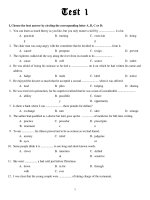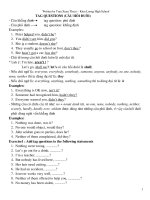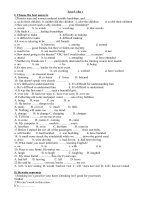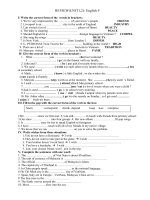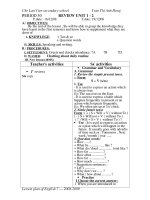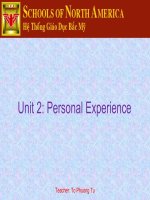Methodology 2 Review
Bạn đang xem bản rút gọn của tài liệu. Xem và tải ngay bản đầy đủ của tài liệu tại đây (120.63 KB, 9 trang )
METHODOLOGY 2 REVIEW
I.
TEACHING PRONUNCIATION.
1. Pronunciation activities.
1. Sounds.
1. Whisper.
2. Minimal pairs.
3. Triplets.
4. Odd one out.
2. Stress.
1. Finding the word stress.
2. Word stress matching.
3. Word stress Bingo.
4. Sentence stress dictation.
5. Guess the meaning of the sentence.
3. Intonation.
Chain drill:
- Organize a chain drill or chain game activity.
- Get students to practice asking and answering questions.
- Make it fun by using surprising information and asking them to
-
respond with the correct phrase and intonation.
Then let them make up their own unusual statements and the others
in their group have to respond appropriately.
2. Teaching tips.
1. Teaching tips to help students hear the sound correctly.
- There are several stages during your lesson when you can focus on
-
sounds.
The drill is a good time for teacher to say the sound correctly several
-
times for the students to repeat it.
Let students watch how you and they make particular sound or
explain it in Vietnamese.
- Ear-training.
- Use dictionaries to find pronunciation.
2. Teaching tips for stress and intonation.
- Use different stages of the lesson to do some pronunciation practice.
- The activities should be short and clear.
- Give students the chance to recognize sounds and patterns before
-
you ask them to reproduce them.
Students must know about stressed and unstressed parts of sentence
so they can get the rhythm of English right.
-
Correct word and sentence stress and intonation are just as important
as getting the individual sounds right.
II.
PRESENTING AND PRACTICING VOCABULARY.
1. Modes of presentation.
1. Ostensive means.
1. Realia.
2. Pictures.
3. Body.
• Facial expression.
• Gesture.
• Mime and actions.
2. Verbal definition.
1. Synonyms.
2. Antonyms.
3. Illustrative sentences.
4. Translation.
5. Word sets.
2. Choosing which word to present.
- There is no firm rule, but most teachers feel that 6 to 8 new words
-
are enough for formal attention.
The words that you select for presentation should be words of
special value, but which are not guessable in the textual context.
3. A step by step presentation procedure.
1. Sound and meaning.
2. Repetition.
3. Written form.
4. Illustrative sentences (optional).
5. Recording vocabulary.
1. Using symbols to record vocabulary.
2. Using word families.
6.
Checking activities.
After all the words have been presented, you can use one of these
activities to check vocabulary.
III.
1. Rub out and remember.
2. What and where.
3. Slap the board.
4. Matching.
5. Bingo.
PRESENTING AND PRACTICING A GRAMMAR STRUCTURE.
1. The presentation of a structure.
1. Presentation of form and meaning.
2. Blackboard examples.
3. Concept checking.
Check use, meaning, form and pronunciation of the structure.
2. What are typical mistakes when teacher do checking?
1. Do you understand?
2. Lengthy questions.
3. Complicated vocabulary.
4. Target item to check target item.
5. Long answers.
6. Over-checking.
3. Showing the meaning of a structure.
- Show what the structure means and how it is used, by giving
-
examples.
Show clearly how the structure is formed, so that students can use it
to make sentences of their own.
1. Showing meaning visually.
2. Showing meaning through a situation.
3. Showing meaning visually and through a situation.
• Guidelines for an effective presentation.
1. Link old and new language.
2. Focus on the new target language.
3. Introduce the language in context.
4. Present one or two structures at a time.
5. Present the new language clearly and simply.
6. Check use, meaning, form and pronunciation.
4. Practice structures.
1. Controlled practice.
• Types of drills.
1. Repetition drill using picture prompts/cues.
2. Repetition drill using word prompts/cues.
3. Substitution drill.
4. Questions and answers drill.
• Steps of a drill:
1. Run through vocabulary.
2. The first cue and second cue.
3. Deal with the second part of the exchange and do as the first part.
4. Put the exchange together.
5. Ask the students to form closed pairs and practice the target
language.
• What are the features of a good drill?
1. A drill should be meaningful.
2. A drill should be consistent and use the same grammatical
pattern for all the utterances.
3. A drill should have a topic so that all the cues and utterances
belong together.
4. A drill should have between 6 and 8 cues.
5. In a drill, students should formulate the utterance for themselves
IV.
from a cue.
2. Less controlled practice.
1. Chain game.
2. Noughts and crosses.
3. Find someone who…?
4. Guessing games.
a. Guess my … (word, sentence).
b. Guessing the place and action.
SHAPE OF A GRAMMAR LESSON.
1. How many stages are there in a grammar lesson?
There are 3 stages. Presentation, Practice and Production.
• Presentation.
Presentation is where the teacher presents the new language.
In this stage, the teacher does the work.
• Practice.
Practice is where the students are made to practice the new language
with the teacher.
At this stage, practice is controlled and the teacher emphasizes
accuracy.
In this stage, the teacher and students do the work.
• Production.
Where the teacher makes the students produce the new language
they have learnt on their own.
The students learn to speak by themselves to achieve fluency.
In this stage, the students do the work.
2. Timing.
1. Presentation: 10
2. Practice: 20
3. Production: 15
3. TTT and STT.
• Presentation: TTT is about 80%
• Practice: TTT is about 40%
• Production: TTT is about 5%
V. SHAPE OF A SKILLS LESSON.
Textbook.
VI. TEACHING READING.
1. Dealing with vocabulary.
• If the new word is essential for understanding the passage and at the
students’ level, it should be taught actively.
• If the new word is essential but above the students’ level, it should
be taught passively.
• If the new word is not essential for understanding the passage but
not too difficult, students should guess the meaning.
• If the new word is both non-essential and difficult, then students
should ignore it.
2. Reading activities.
1. What is the purpose of pre-reading stage?
This stage is to prepare the learners for what they are going to read.
A. Pre-reading tasks:
1. Guess the topic of the text from the heading.
2. Brainstorming around a topic word on the board.
3. Predict what the text will say.
4. Write questions that may be answered by the text.
B. Pre-reading techniques.
1. Ordering statements/pictures.
2. Jigsaw dictation.
3. True/False statement prediction.
4. Brainstorming.
5. Skimming questions.
2. What is the purpose of while-reading stage?
This stage is to help the learners understand the text.
A. While-reading tasks.
1. Scan for 2 or 4 items for information.
2. Skim for the general idea.
3. Answer questions.
4. Complete sentences.
5. Complete a table, map or picture.
6. Ask each other questions.
B. While-reading techniques.
1. T/F, Y/N, R/W questions and statements.
2. Answers given.
3. Comprehension questions.
4. Multiple choice.
5. Gap-fill.
6. Grids or forms.
7. Matching.
3. What is the purpose of post-reading stage?
This stage is to help the learners to connect what they have read with
their own ideas and experience.
A. Post-reading tasks.
1. Discuss what was interesting or new in the text.
2. Discuss or debate the topic of the text if is controversial.
3. Do tasks on the language or structure of the text.
4. Summarize the text, either orally or in writing.
B. Post-reading techniques.
1. ‘Wh’ questions.
2. Gap-fill.
3. Role play.
VII.
4. Rewrite.
5. Discussion.
TEACHING LISTENING.
1. Features of a good listening activity.
- A good listening activity does many things.
- A good listening activity focuses students’ attention through
questions, grids, and visuals.
2. What is the purpose of pre-listening stage?
This stage is to prepare the learners for what they are going to listen.
A. Pre-listening tasks.
1. Discuss a relevant picture.
2. Discuss relevant experiences.
3. Associate ideas with the topic.
4. Associate vocabulary with the topic.
5. Predict information about the topic.
6. Write questions about the topic.
B. Pre-listening techniques.
1. True/false statements prediction.
2. Open prediction/Brainstorming.
3. Ordering pictures/statements/words.
4. Pre-questions.
3. What is the purpose of while-listening stage?
This stage is to help the learners understand the text.
A. While-listening tasks.
1. Identify the exact topic, or an aspect of it.
2. Note 2 or 4 pieces of information.
3. Answer questions.
4. Complete sentences.
5. Complete a table, map or picture.
B. While-listening techniques.
1. Selecting.
2. Deliberate mistakes.
3. Grids or tables
4. Listen and draw.
4. What is the purpose of post-listening stage?
This stage is to help the learners connect what they have heard with their
own ideas and experiences.
A. Post-listening tasks.
1. Give opinions.
2. Relate similar experiences.
3. Role-play a similar interaction.
4. Write a brief report.
5. Write a similar text.
6. Debate the topic.
B. Post-listening techniques.
1. Recall the story.
2. Write it up
3. Role play
4. Personalization.
5. Discussion.
VIII. TEACHING WRITING.
1. Writing.
Good writing skills usually develop from extensive reading, some specific
training, and a good deal of practice.
Writing involves the following basic skills.
- Handwriting or typing.
- Spelling.
- Constructing grammatical sentences.
- Punctuating.
2. From controlled to free writing.
1. Transformation.
2. Gap-fill.
3. Questions and answers.
4. Substitution boxes.
5. Write it up.
6. Composition.
3. Writing activities.
A. Pre-writing.
1. Using a drill.
2. Using a listening activity.
3. Using a survey.
4. Using picture dictation.
5. Using a reading text.
B. While-writing.
1. Transformation.
2. Substitution tables.
3. Substitution boxes.
4. Gap-fill.
5. Questions and answers.
6. Write it up.
7. Ordering.
8. Brainstorming.
C. Post-writing.
1. Correction.
2. Sharing and comparing.
3. Exhibition.
IX. TEACHING SPEAKING.
Textbook.
The End!...

